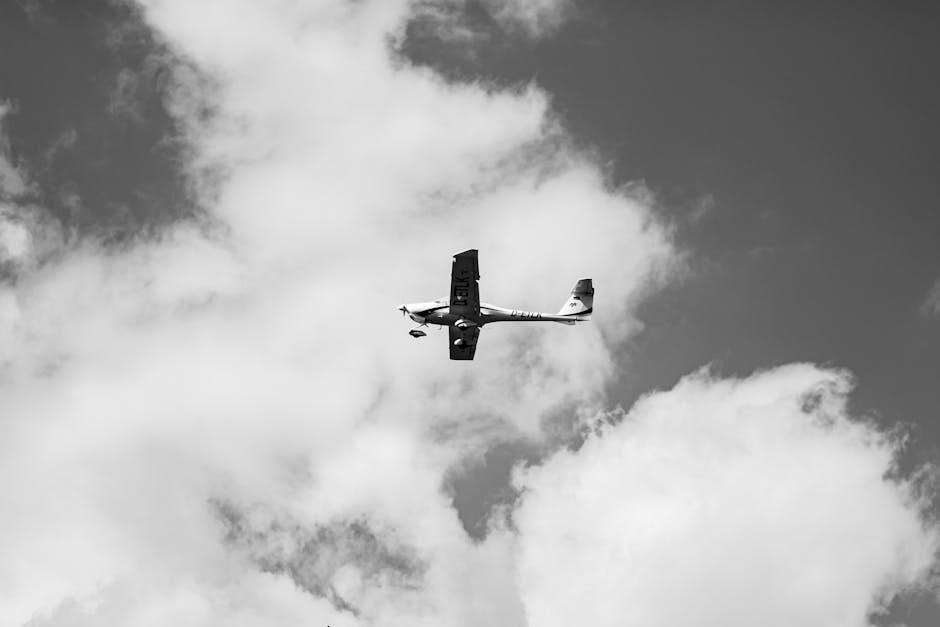The Cessna 172S POH is a comprehensive guide detailing aircraft specifications, performance, and operational procedures. It includes nine sections, covering everything from general characteristics to emergency protocols, ensuring safe and efficient flight operations for pilots. This manual is essential for understanding the aircraft’s capabilities and limitations, making it an indispensable resource for both new and experienced pilots.
Overview of the Cessna 172S Aircraft
The Cessna 172S is a four-seat, single-engine aircraft renowned for its reliability and efficiency. Designed for both flight training and personal use, it features a robust airframe, fuel-efficient engine, and advanced avionics. Equipped with the Garmin G1000 NXi avionics system, the 172S offers enhanced navigation and flight management capabilities. Its durable construction and forgiving handling make it an ideal platform for student pilots and experienced aviators alike. The aircraft is certified for day and night VFR and IFR operations, ensuring versatility in various flight conditions. With its proven track record, the Cessna 172S remains a cornerstone in aviation training and recreational flying worldwide.
Structure and Content of the POH
The Cessna 172S POH is organized into nine comprehensive sections, providing detailed information for safe and efficient aircraft operation. It includes sections on operating limitations, performance data, aircraft systems, and emergency procedures. The manual also covers pre-flight and post-flight checks, maintenance requirements, and compliance with airworthiness directives. Supplementary data, such as optional equipment and FAA-approved modifications, is also included; The POH is structured to ensure pilots have access to critical information, adhering to FAA regulations and standards. Its clear layout and detailed content make it an essential resource for understanding and operating the Cessna 172S safely and effectively.
Importance of the POH for Pilots
The POH is a critical resource for pilots, providing essential information for the safe and efficient operation of the Cessna 172S. It contains detailed performance data, operating limitations, and emergency procedures, ensuring pilots are well-prepared for all flight scenarios. Compliance with the POH is mandatory for maintaining safety and regulatory standards. It serves as a foundational document for pilot training, offering insights into aircraft systems, weight and balance calculations, and maintenance requirements. By adhering to the guidelines outlined in the POH, pilots can optimize aircraft performance, minimize risks, and ensure compliance with FAA regulations. This manual is indispensable for both novice and experienced pilots seeking to master the Cessna 172S.

Aircraft Description
The Cessna 172S is a single-engine, high-wing aircraft renowned for its stability and versatility. It features the GFC 700 autopilot and Garmin G1000 avionics system.
General Characteristics of the Cessna 172S
The Cessna 172S is a single-engine, high-wing aircraft known for its stability and durability. It features a 180 HP engine, delivering a maximum cruise speed of 140 knots. The G1000 NXi avionics suite enhances navigation and situational awareness. Its design includes a robust airframe and a comfortable cabin with seating for four, ideal for both training and cross-country flights. With a fuel capacity supporting extended range, the 172S offers versatility for diverse flying needs, making it a reliable choice for pilots seeking performance and comfort.
Model Variants and Upgrades
The Cessna 172S has undergone several upgrades, including the integration of the GFC 700 autopilot system, enhancing stability and navigation. The Garmin G1000 NXi avionics suite offers advanced flight deck capabilities, improving situational awareness. The Nav III configuration includes enhanced GPS and communication systems, while the KAP 140 autopilot provides automated flight control. These upgrades ensure the aircraft remains modern and efficient, catering to both training and personal use. The 172S also features a durable design and reliable engine performance, making it a popular choice for pilots seeking versatility and advanced technology in a proven airframe.
Key Features of the Cessna 172S
The Cessna 172S is equipped with the GFC 700 autopilot system, offering advanced automation for stable and precise flight control. The Garmin G1000 NXi avionics suite provides a modern glass cockpit, enhancing situational awareness and navigation capabilities. The aircraft features a durable, high-wing design, ensuring excellent visibility and stability during flight. Its robust engine delivers reliable performance, while the spacious cabin accommodates up to four passengers, making it ideal for training and private use; The 172S also includes features like dual USB ports, soft LED lighting, and ergonomic seating, ensuring comfort during extended flights; These features collectively make the Cessna 172S a versatile and reliable aircraft for various aviation needs.

Operating Limitations
The Cessna 172S operating limitations outline weight and balance specifications, performance limits, and environmental constraints to ensure safe and efficient flight operations under various conditions.
Weight and Balance Specifications
The Cessna 172S POH provides detailed weight and balance specifications to ensure safe aircraft operation. The maximum takeoff weight is 2,550 pounds, with an empty weight of approximately 1,670 pounds, leaving a useful load of 880 pounds. Pilots must adhere to these limits to avoid performance degradation or safety risks. The POH includes charts and calculations to determine the center of gravity, ensuring proper loading. Exceeding weight limits can compromise aircraft structural integrity and handling. Adhering to these guidelines is crucial for maintaining safety and optimal performance during all flight phases, as outlined in the POH.
Performance Limits and Restrictions
The Cessna 172S POH outlines specific performance limits and restrictions to ensure safe and efficient flight operations. The aircraft’s maximum speed is 163 knots, with a cruise speed of 122 knots at 8,000 feet. It is approved for day and night VFR/IFR operations. The POH restricts flight into icing conditions without proper certification. Additionally, it specifies altitude limits and prohibited maneuvers, such as aerobatics. Pilots must comply with these guidelines to maintain aircraft integrity and performance. Exceeding these limits can lead to reduced aircraft efficiency or potential safety hazards, emphasizing the importance of adhering to the specified parameters for optimal flight performance and safety.
Environmental and Operational Limits
The Cessna 172S POH specifies environmental and operational limits to ensure safe flight operations. The aircraft is approved for day and night VFR/IFR operations, with a maximum operating altitude of 14,000 feet. It is not certified for flight in icing conditions unless equipped with approved ice protection systems. The POH prohibits operation in extreme weather conditions, such as thunderstorms or tornadoes. Additionally, it outlines temperature and humidity limits for engine operation and fuel usage. Pilots must adhere to these guidelines to maintain safety and performance. Exceeding these limits can compromise aircraft efficiency and safety, making compliance essential for optimal flight outcomes and system reliability.
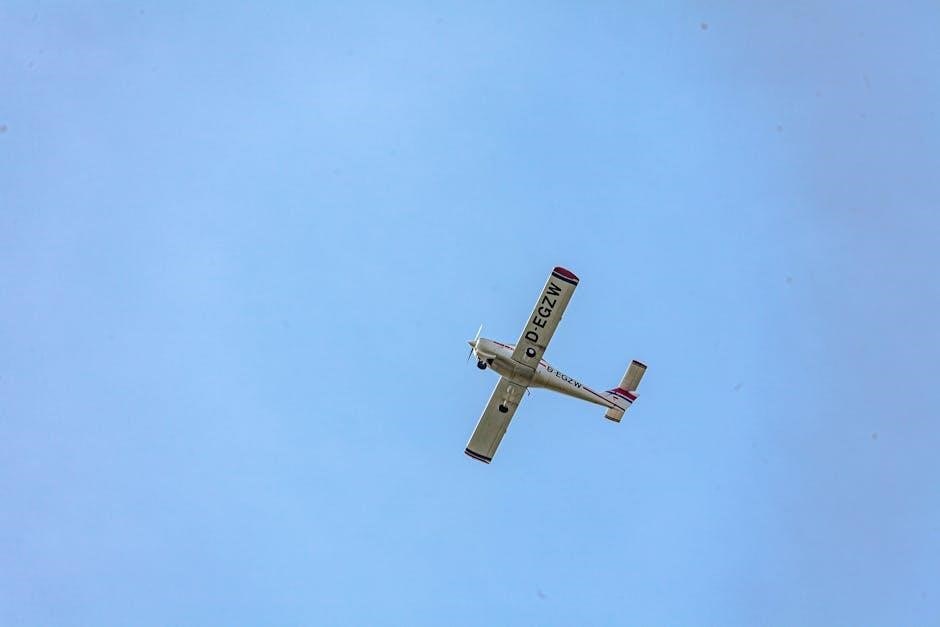
Flight Controls and Instruments
The Cessna 172S features primary flight controls, including a yoke, rudder pedals, and throttle. Secondary controls include flaps, trim, and carburetor heat. The GFC 700 autopilot supports altitude and navigation functions, while the Garmin G1000 avionics system provides advanced flight instrumentation and navigation tools, enhancing situational awareness and operational efficiency for pilots.
Primary and Secondary Flight Controls
The Cessna 172S is equipped with a comprehensive set of primary and secondary flight controls. Primary controls include the control yoke for roll and pitch, rudder pedals for yaw, and the throttle for engine power management. Secondary controls encompass flaps, trim, and carburetor heat, which aid in optimizing aircraft performance during various phases of flight. The GFC 700 autopilot system further enhances control by automating altitude, heading, and navigation functions. These systems work in tandem to provide precise control and reduce pilot workload, ensuring smooth and efficient flight operations. The integration of these controls is detailed in the POH, emphasizing their proper use for safe and effective flying.
Avionics and Navigation Systems
The Cessna 172S features advanced avionics and navigation systems, including the Garmin G1000 NXi flight deck. This system provides a primary flight display (PFD) and multi-function display (MFD), offering real-time data, synthetic vision, and advanced navigation tools. The GFC 700 autopilot is fully integrated, enabling automated control of altitude, heading, and navigation functions. Additional features include WAAS-enabled GPS for precision approaches and ADS-B In/Out for enhanced situational awareness. These systems streamline flight operations and improve safety, making the Cessna 172S an exceptional choice for both training and personal flying. The POH details the operation and capabilities of these avionics, ensuring pilots can utilize them effectively for optimal performance.
GFC 700 Autopilot System
The GFC 700 Autopilot System in the Cessna 172S is a state-of-the-art flight control system designed to reduce pilot workload and enhance flight safety. Integrated with the Garmin G1000 NXi avionics suite, it offers advanced features such as altitude hold, heading select, and navigation tracking. The system supports various lateral and vertical modes, including LNAV, VNAV, and approach navigation, ensuring precise flight path control. Pilots can engage the autopilot at altitudes above 500 feet AGL, allowing for hands-off operation during climbs, descents, and navigation. The GFC 700 also includes a dedicated heading knob for easy control adjustments. This system significantly improves situational awareness and flight efficiency, making it an invaluable tool for both training and cross-country flights.
Performance Data
The Cessna 172S delivers exceptional performance with a max speed of 172 knots, a service ceiling of 14,200 ft, and a range of 900 nm. Its fuel efficiency and reliability make it ideal for both training and cross-country flights.
Takeoff and Landing Performance
The Cessna 172S POH provides detailed takeoff and landing performance data, including speeds, distances, and configurations. With the GFC 700 autopilot, the aircraft offers enhanced stability during these critical phases. The manual specifies optimal flap settings, climb rates, and ground roll distances, ensuring safe and efficient operations. It also covers the effects of weight, altitude, and temperature on performance, providing pilots with essential data for various conditions. The POH includes charts and tables to help calculate precise takeoff and landing distances, making it an invaluable resource for pilots to master these fundamental flight procedures.
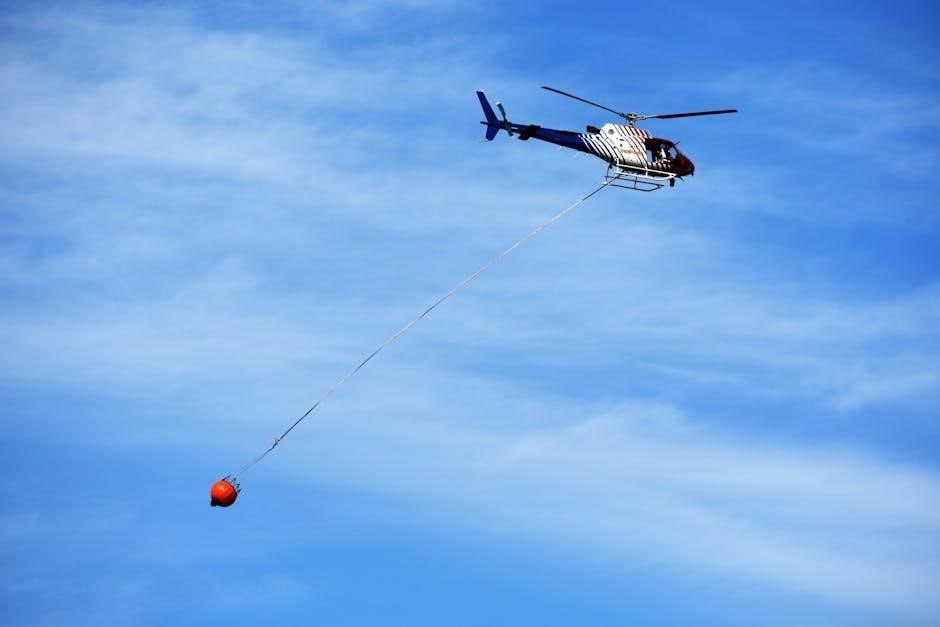
Climb and Cruise Performance
The Cessna 172S POH details climb and cruise performance, providing pilots with essential data for optimal flight management. Climb performance includes recommended airspeeds, altitude gains, and power settings, ensuring efficient ascents. Cruise performance data covers fuel efficiency, power management, and speed ranges, helping pilots achieve economical flight operations. The manual also addresses the impact of weight, altitude, and temperature on performance, offering guidance for various flight conditions. With the GFC 700 autopilot system, pilots can maintain stable climb and cruise phases, enhancing overall flight efficiency. This section is crucial for pilots to maximize the aircraft’s capabilities while ensuring safe and efficient flight operations.
Range and Endurance Calculations
The Cessna 172S POH provides detailed methodologies for calculating range and endurance, enabling pilots to plan flights accurately; Factors such as fuel capacity, consumption rates, and flight conditions are considered. The manual offers formulas and data to determine maximum range and endurance under various power settings and altitudes. Pilots can use this information to optimize flight planning, ensuring efficient fuel use and compliance with operational limits. The POH also includes guidelines for adjusting calculations based on aircraft weight, weather, and terrain, helping pilots achieve their mission requirements safely and efficiently. This section is vital for long-distance flights and fuel-critical operations.
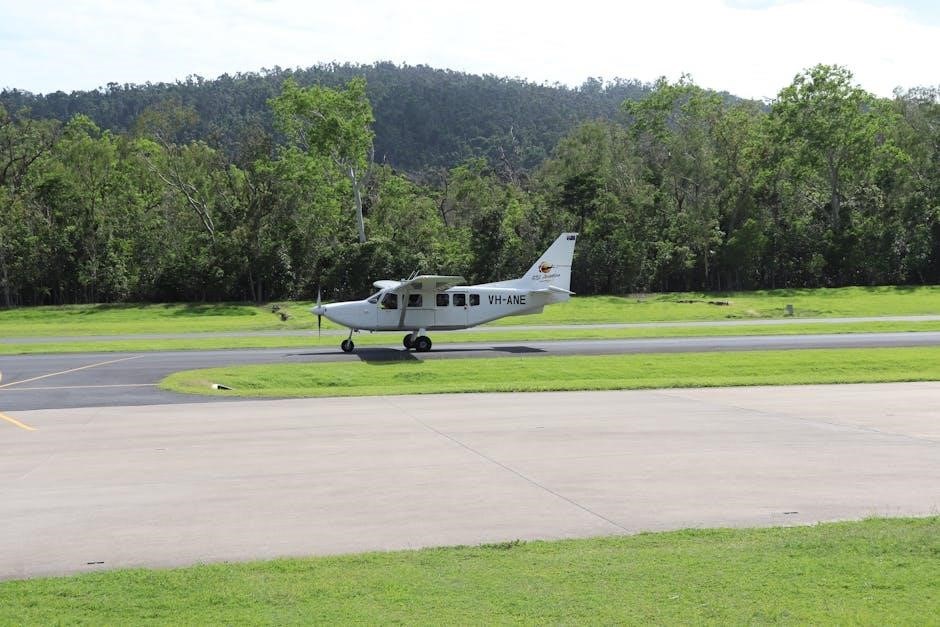
Aircraft Systems
The Cessna 172S features a robust engine, fuel, and electrical system design, ensuring reliable performance. Its avionics, including the GFC 700 autopilot, enhance flight precision and safety.
Engine and Propeller Systems
The Cessna 172S is powered by a Lycoming IO-360-L2A engine, producing 180 horsepower. This engine features a fuel injection system for improved efficiency and reliability. The propeller system includes a two-blade, fixed-pitch McCauley propeller designed for optimal performance across various flight regimes. The engine’s operation is detailed in the POH, including startup procedures, fuel management, and emergency protocols. Regular maintenance schedules are outlined to ensure longevity and safety. The combination of a robust engine and efficient propeller makes the 172S a reliable choice for training and personal flying, delivering consistent performance under diverse conditions.
Fuel and Hydraulic Systems
The Cessna 172S features a gravity-fed fuel system with two wing tanks, each holding 26.5 gallons, for a total capacity of 53 gallons. Fuel is fed to the engine through a selector valve, allowing pilots to switch between tanks. The hydraulic system is relatively simple, primarily supporting the brake system. The POH details proper fuel management, including fuel tank selection, contamination checks, and refueling procedures. Hydraulic fluid levels and system inspections are also outlined to ensure optimal performance and safety. Adhering to these guidelines is crucial for maintaining aircraft efficiency and reliability during flight operations.
Electrical and Avionics Systems
The Cessna 172S is equipped with a 12-volt electrical system, powered by a battery and alternator, ensuring reliable power distribution. The Garmin G1000 NXi avionics suite is a standout feature, offering advanced navigation, communication, and flight instrument capabilities. The system integrates a primary flight display, multi-function display, and engine monitoring, enhancing situational awareness. The GFC 700 autopilot system provides automatic flight control, including altitude, heading, and navigation tracking. Proper operation of these systems requires adherence to POH guidelines for power management, avionics setup, and pre-flight checks. Regular inspections and maintenance of electrical and avionics components are crucial for optimal performance and safety.

Emergency Procedures
- Engine failure protocols, including restart procedures and emergency landings.
- System malfunctions, such as electrical or hydraulic failures, and recovery steps.
- Emergency landing techniques and post-landing evacuation procedures.
Engine Failure and Restart Procedures
In the event of engine failure, the Cessna 172S POH outlines critical steps to ensure pilot and passenger safety. First, the pilot must secure the engine to prevent further damage, which includes adjusting the throttle, mixture, and ignition settings. If conditions permit, a restart attempt can be made by following the restart checklist. This involves enriching the fuel-air mixture, advancing the throttle slightly, and cycling the ignition. If the engine fails to restart, the pilot should prepare for an emergency landing, selecting a suitable site and configuring the aircraft for landing. The POH emphasizes adherence to these procedures to maximize safety and minimize risks.
System Malfunction and Recovery
The Cessna 172S POH provides detailed procedures for addressing system malfunctions, ensuring safe and effective recovery. Pilots are guided through identifying the issue, isolating affected systems, and implementing corrective actions. For electrical system failures, the POH recommends switching to essential power sources and resetting circuit breakers if necessary. Hydraulic system malfunctions require careful management of pressure and fluid levels. The manual also outlines steps for fuel system issues, such as switching fuel tanks or addressing vapor lock scenarios. Recovery procedures emphasize maintaining aircraft control while troubleshooting. The POH stresses the importance of adhering to checklist protocols and consulting the manual for specific system-related emergencies to ensure safe continuation of flight or preparation for landing.
Emergency Landing and Evacuation
The Cessna 172S POH outlines clear procedures for emergency landings and evacuations, ensuring pilot and passenger safety. In case of an unavoidable landing, pilots are instructed to select a safe site, configure the aircraft for landing, and alert passengers. Post-landing, the engine and electrical systems must be secured to prevent fires. Evacuation procedures include opening doors, assisting passengers, and moving away from the aircraft. The manual emphasizes quick and orderly evacuation, with a final check to ensure all occupants have exited safely. These steps are designed to minimize risks and protect lives during critical situations, adhering to FAA guidelines and best practices for emergency protocols.
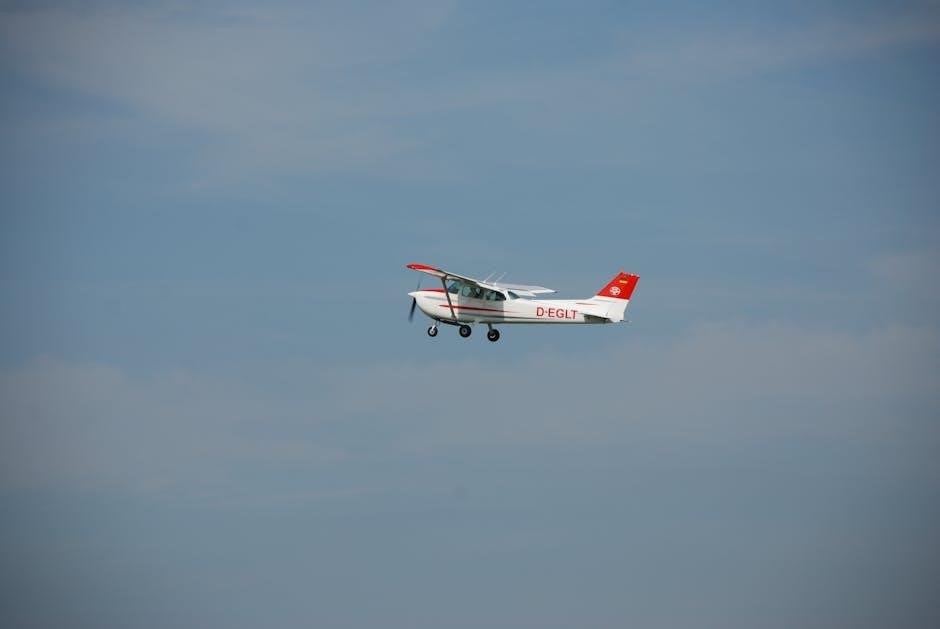
Maintenance and Inspection
The Cessna 172S POH outlines scheduled maintenance requirements, pre-flight inspections, and compliance with airworthiness directives, ensuring adherence to FAA standards for continued safety and optimal aircraft performance.
Scheduled Maintenance Requirements
The Cessna 172S POH details periodic inspections and maintenance tasks to ensure airworthiness. These include 50-hour, annual, and 100-hour inspections, as well as specific component replacements. Compliance with FAR Part 23 and manufacturer recommendations is mandatory. Regular lubrication of moving parts, tire pressure checks, and battery maintenance are emphasized. Adhering to these schedules prevents premature wear and ensures optimal performance. Pilots and mechanics must follow these guidelines to maintain safety and regulatory compliance, as outlined in the POH. Proper documentation of all maintenance activities is required to verify adherence to the specified intervals and procedures.
Pre-Flight and Post-Flight Checks
The Cessna 172S POH outlines detailed pre-flight and post-flight inspection procedures to ensure aircraft safety and readiness. Pre-flight checks include examining the exterior for damage, verifying control surfaces, checking tire condition, and ensuring proper fluid levels. The interior inspection involves testing instruments, radios, and lights, as well as securing loose items. Post-flight procedures involve securing the aircraft, recording flight hours, and noting any discrepancies. Adhering to these routines helps identify potential issues early, ensuring compliance with safety standards and maintaining aircraft airworthiness; Proper documentation of these checks is essential for tracking maintenance and ensuring regulatory compliance.
Compliance with Airworthiness Directives
The Cessna 172S POH emphasizes the importance of adhering to airworthiness directives (ADs) issued by regulatory authorities. These directives are mandatory instructions for correcting unsafe conditions or improving aircraft performance. The POH provides a list of applicable ADs, outlining specific inspections, modifications, or procedures required for compliance. Pilots and owners must ensure all ADs are addressed to maintain the aircraft’s airworthiness certification. Non-compliance can result in legal penalties and operational restrictions. Regular reviews of ADs are crucial to stay updated on safety requirements and ensure the aircraft remains in optimal condition for flight. Compliance is a shared responsibility between pilots, owners, and maintenance personnel.
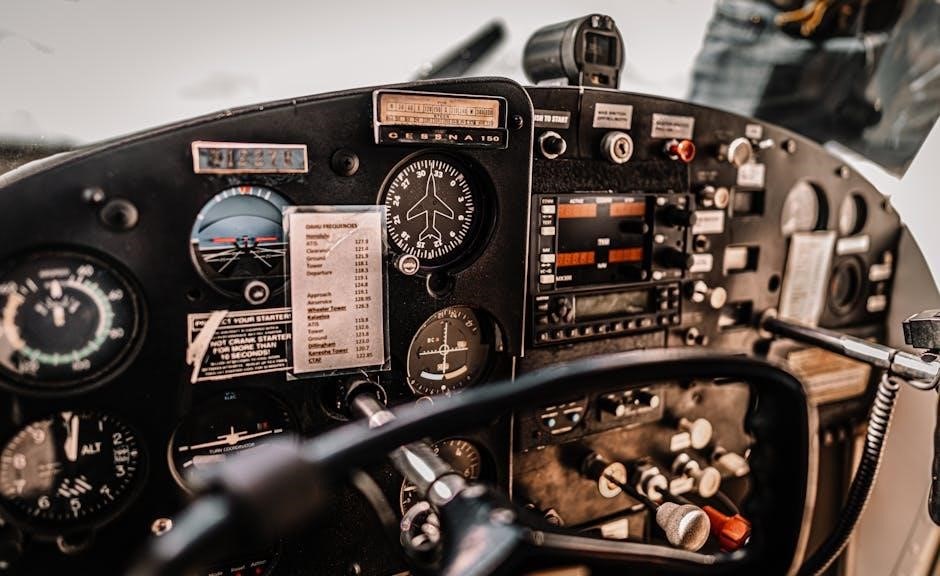
Legal and Regulatory Compliance
The Cessna 172S POH ensures adherence to FAR Part 23 standards and international aviation regulations, guaranteeing safe and lawful aircraft operation through rigorous compliance with established guidelines.
FAR Part 23 Compliance
The Cessna 172S adheres to Federal Aviation Regulations (FAR) Part 23, which governs airworthiness standards for small aircraft. This compliance ensures the aircraft meets rigorous safety, performance, and design requirements. The POH includes all necessary data to satisfy FAR Part 23, providing pilots with critical information for legal and safe operation. The aircraft’s certification under FAR Part 23 confirms its reliability for training, personal, and commercial use. Adherence to these regulations is verified through extensive testing and documentation, ensuring the Cessna 172S operates within established safety margins and performance parameters. This compliance is essential for maintaining the aircraft’s airworthiness and operational integrity.
International Operation Requirements
The Cessna 172S POH addresses international operation requirements, ensuring compliance with global aviation standards. Pilots must adhere to local regulations and certifications when flying internationally. The POH includes specific guidelines for operations in countries like Brazil, detailing necessary configurations and approvals. Compliance with international noise regulations, emissions standards, and airworthiness directives is also emphasized. The manual provides essential data for global operations, ensuring the aircraft meets the requirements of foreign aviation authorities. This enables safe and legal operation of the Cessna 172S in diverse international environments, making it a versatile choice for pilots worldwide. Adherence to these standards is crucial for maintaining operational safety and legal compliance.
Documentation and Record-Keeping
Proper documentation and record-keeping are critical for maintaining compliance and ensuring the Cessna 172S operates safely. The POH emphasizes the importance of accurate flight logs, maintenance records, and compliance documentation. Pilots must maintain detailed records of flight hours, inspections, and any modifications made to the aircraft. The manual also outlines requirements for documenting temporary revisions and updates, ensuring all changes are tracked and approved. Additionally, the POH includes sections on record-keeping for airworthiness directives and FAA-approved changes. These practices ensure transparency, accountability, and adherence to regulatory standards, ultimately supporting the aircraft’s safety and operational integrity for years to come.

Supplements and Updates
The POH includes temporary revisions, updates, and FAA-approved changes. Optional equipment and modifications are detailed, ensuring the aircraft remains compliant with the latest regulatory standards.
Temporary Revisions and Updates
Temporary revisions and updates to the Cessna 172S POH are issued periodically to reflect new features, regulatory changes, or operational improvements. These updates ensure compliance with FAA standards and enhance safety. They are incorporated into the manual as needed, providing pilots with the most current information. Temporary revisions are clearly marked and often include updates to performance data, system functionality, or procedural guidelines. Pilots must review these updates to maintain proficiency and adhere to aircraft specifications. The POH is regularly updated to address evolving aviation requirements, making it a dynamic and essential resource for Cessna 172S operators.
Optional Equipment and Modifications
The Cessna 172S POH allows for optional equipment and modifications to enhance performance and functionality. These include avionics upgrades such as the Garmin G1000 NXi, which improves navigation and situational awareness. Additionally, modifications like engine upgrades or propeller changes can boost performance. Interior enhancements, such as premium seating and lighting, may also be installed for improved comfort. Optional autopilot systems, such as the GFC 700, can reduce pilot workload during flight. These modifications are detailed in the POH to ensure compliance with FAA standards and maintain aircraft airworthiness. Pilots should review all optional features to optimize their flying experience and operational needs.
FAA Approved Changes and Supplements
The Cessna 172S POH includes FAA-approved changes and supplements to ensure compliance with current aviation regulations. These updates are issued to reflect modifications, improvements, or new requirements for the aircraft. Temporary revisions and service bulletins are incorporated into the POH to provide pilots with the most accurate and up-to-date information. FAA-approved changes may include updates to performance data, operational limits, or system functionalities. Pilots must adhere to these updates to maintain airworthiness and ensure safe flight operations. Supplements are also provided for optional equipment installations, such as advanced avionics or autopilot systems, which have been approved by the FAA for use in the Cessna 172S.
The Cessna 172S POH is an essential resource for pilots, providing critical information for safe and efficient flight operations while ensuring compliance with aviation standards.
The Cessna 172S POH is a detailed manual divided into nine sections, covering aircraft characteristics, performance, and operational guidelines. It includes essential information for pilots, such as weight and balance specifications, emergency procedures, and maintenance requirements. The manual emphasizes compliance with FAR Part 23 and provides data on systems like the GFC 700 autopilot. Key features include takeoff and landing performance, climb and cruise data, and environmental limits. It also outlines pre-flight and post-flight checks, ensuring safe and efficient operations. This handbook is a critical resource for understanding the aircraft’s capabilities and limitations, making it indispensable for both training and professional flying environments.
Final Thoughts on the Cessna 172S POH
The Cessna 172S POH is an indispensable resource for pilots, offering detailed insights into aircraft operations, performance, and safety protocols. It serves as a comprehensive guide, ensuring compliance with regulatory standards and providing essential data for efficient flight management. The inclusion of advanced systems like the GFC 700 autopilot underscores its relevance for modern aviation. By adhering to the POH, pilots can optimize aircraft capabilities while maintaining safety and efficiency. This manual remains a cornerstone for training and operational excellence, reinforcing the importance of standardized procedures in aviation. Its thoroughness makes it a vital tool for both instructors and pilots seeking to master the Cessna 172S.
